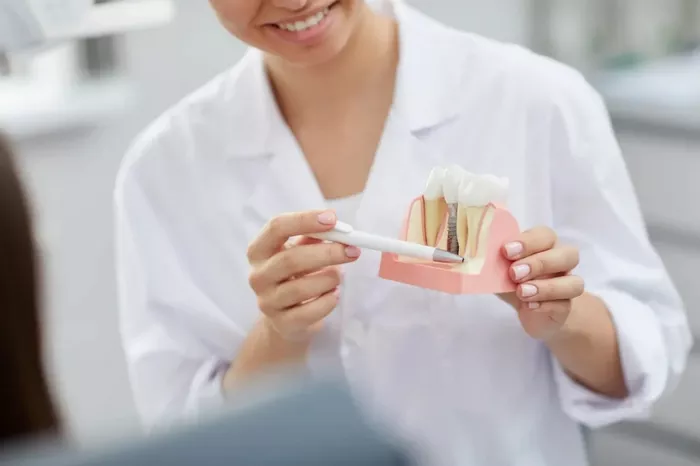Dental implants are a popular and effective solution for replacing missing teeth. One of the most important concepts in implantology is “implant torque.” Understanding what it means when an implant is “torqued” is critical for ensuring successful outcomes in dental implant procedures. This article explores what implant torque means, why it’s vital, how it’s measured, and how it affects healing and long-term success.
Understanding Dental Implants
Before diving into the meaning of implant torque, it is helpful to briefly review what a dental implant is. A dental implant is a small, screw-like device made of titanium or zirconia that is surgically placed into the jawbone. It acts as an artificial tooth root to support crowns, bridges, or dentures. For a dental implant to succeed, it must achieve stability in the jawbone, and this is where torque comes in.
What is Implant Torque?
In the context of dental implantology, torque refers to the rotational force applied to the implant during its placement into the bone. Torque is typically measured in Newton centimeters (Ncm). When an implant is “torqued,” it means a specific amount of rotational force has been used to secure the implant into the bone. This process is essential for assessing the primary stability of the implant.
Primary vs. Secondary Stability
There are two types of stability involved in implant placement:
Primary stability: The mechanical engagement of the implant with the bone at the time of placement.
Secondary stability: The biological stability that develops over time as the bone heals and integrates with the implant (osseointegration).
Torque values are crucial in determining whether primary stability has been achieved, which directly influences secondary stability and the overall success of the implant.
How Is Implant Torque Measured?
Implant torque is measured using torque drivers or digital torque wrenches. These tools allow the clinician to apply a controlled and measured amount of force. Torque values can range from low (15–20 Ncm) to high (above 35 Ncm), depending on the bone quality, implant type, and clinical situation.
Optimal Torque Ranges
The ideal torque value for immediate or early loading of implants typically ranges between 30 to 45 Ncm. Values below 25 Ncm often indicate insufficient primary stability, which may delay prosthetic loading. On the other hand, torquing an implant above 50 Ncm may cause bone compression or necrosis, leading to implant failure.
Factors Influencing Torque Values
Several variables affect the torque that can be achieved during implant placement:
1. Bone Density
Bone quality plays a significant role. Dense cortical bone allows higher torque levels, while softer cancellous bone limits the force that can be applied without damaging the tissue.
2. Implant Design
Implants with aggressive thread designs tend to provide better engagement with bone, enabling higher torque. The diameter and length of the implant also influence the torque that can be applied.
3. Drilling Protocol
The size of the osteotomy relative to the implant diameter affects insertion torque. Under-prepared osteotomies (slightly smaller than the implant) can lead to higher torque values but may increase the risk of bone trauma.
4. Surgical Technique
The skill and experience of the clinician, as well as their chosen surgical technique (e.g., flapless, guided), can impact torque outcomes. Controlled and consistent insertion techniques help maintain ideal torque levels.
Clinical Significance of Implant Torque
Understanding and controlling torque during implant placement is essential for several reasons:
1. Predicts Implant Stability
Torque values help clinicians gauge the initial mechanical stability of the implant, which is vital for immediate loading protocols.
2. Influences Healing Protocol
Lower torque may necessitate a longer healing phase before placing the prosthetic crown. High torque allows for faster loading but must be within safe limits to avoid over-compression.
3. Impacts Long-Term Success
Proper torque values reduce the risk of micromotion at the implant site, which can hinder osseointegration. Long-term success depends heavily on the initial stability achieved through optimal torque.
Consequences of Incorrect Torque
Applying incorrect torque—either too low or too high—can jeopardize the implant procedure:
Low Torque Issues
- Poor primary stability
- Delayed healing and loading
- Higher failure risk due to micromovement
High Torque Issues
- Bone compression or necrosis
- Implant surface damage
- Loss of bone-to-implant contact
Torque During Abutment Connection
Torque is not only relevant during implant placement but also during the attachment of prosthetic components. Abutments and screws must be torqued according to manufacturer specifications (often between 20–35 Ncm) to avoid loosening or fracture.
Torque and Immediate Loading Protocols
Immediate loading involves placing the prosthetic restoration soon after the implant is inserted. This requires a high level of primary stability, usually confirmed by achieving torque values above 35 Ncm. In such cases, the implant must not only be torqued sufficiently but also placed in favorable bone conditions.
Role of Reverse Torque Testing
Reverse torque testing is sometimes performed to assess the osseointegration of an implant. A small amount of reverse torque (usually 20 Ncm) is applied to the implant to test its resistance. If the implant remains stable, it indicates successful bone integration. However, this test is controversial and not routinely used, as it may disrupt integration.
Torque vs. Insertion Speed
Torque must also be balanced with insertion speed. Too fast an insertion speed can generate heat and damage bone cells. Slow, controlled torque application ensures better outcomes by minimizing thermal trauma and allowing the implant threads to engage effectively with the bone.
Conclusion
In conclusion, when a dental implant is “torqued,” it means it has been inserted with a measured amount of rotational force to ensure its stability. Proper implant torque is essential for primary stability, osseointegration, and the long-term success of the implant. Understanding this concept helps clinicians make informed decisions about timing, loading, and surgical technique, ultimately improving patient outcomes. With advancements in torque monitoring and digital tools, dental professionals can now achieve safer, more predictable implant results than ever before.
Related topics

